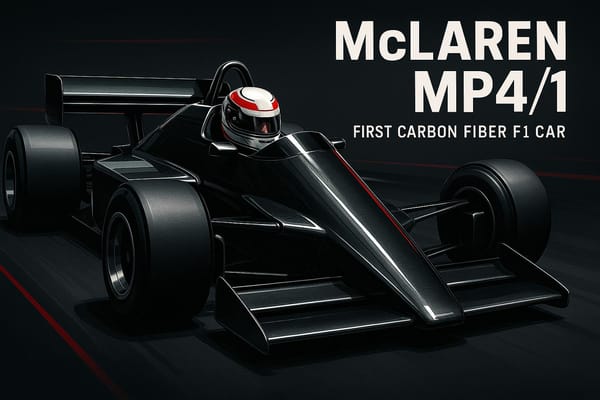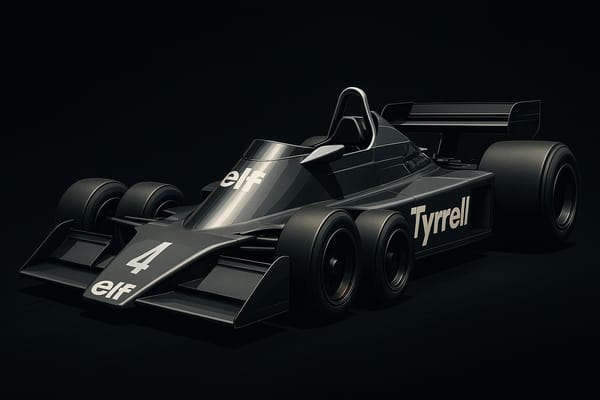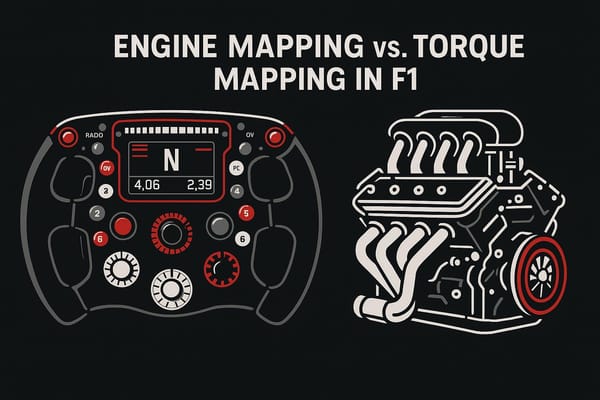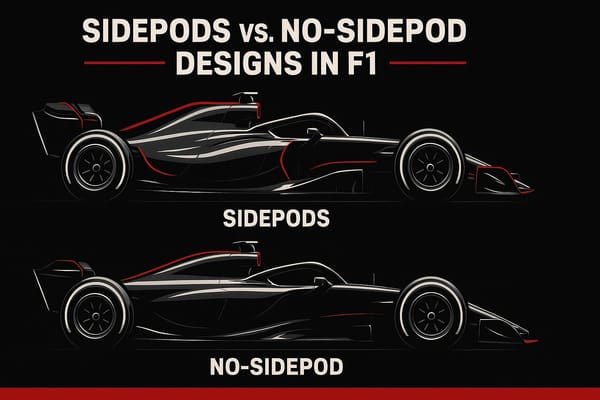Night Speed in Jeddah: F1’s Fastest Street Race at the 2025 Saudi Arabian Grand Prix
The 2025 Saudi Arabian Grand Prix at Jeddah highlights speed, strategy, and precision, with Oscar Piastri claiming victory in F1's fastest street race.
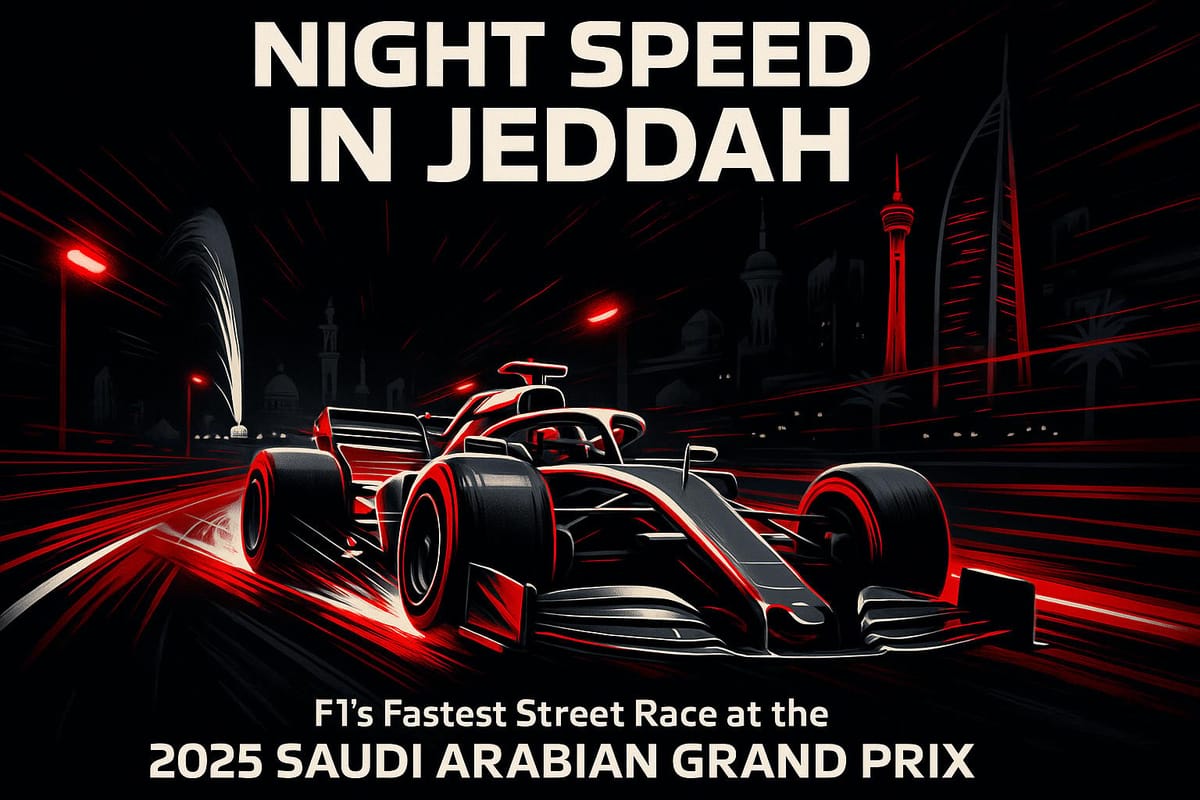
The 2025 Saudi Arabian Grand Prix showcased the Jeddah Corniche Circuit as Formula One's fastest and most intense street track. With an average speed of 157.1 mph and 79% of each lap spent at full throttle, the 6.174 km circuit combines high-speed challenges with technical precision. Key highlights include:
- Oscar Piastri's Victory: Piastri claimed his third win of the season, ending Red Bull's dominance and taking the lead in the Drivers' Championship.
- Track Design: 27 corners and long straights demand a balance between speed and control, with DRS zones providing overtaking opportunities.
- Night Racing Complexity: Cooler temperatures, artificial lighting, and high-speed corners tested drivers' focus and adaptability.
- Tire Strategies: Softer compounds introduced in 2025 led to dynamic race tactics, influenced by frequent safety car interventions.
This race emphasized the fine balance of speed, strategy, and precision, solidifying Jeddah’s status as a premier F1 venue.
Jeddah Corniche Circuit: The Fastest Street Track in Formula One
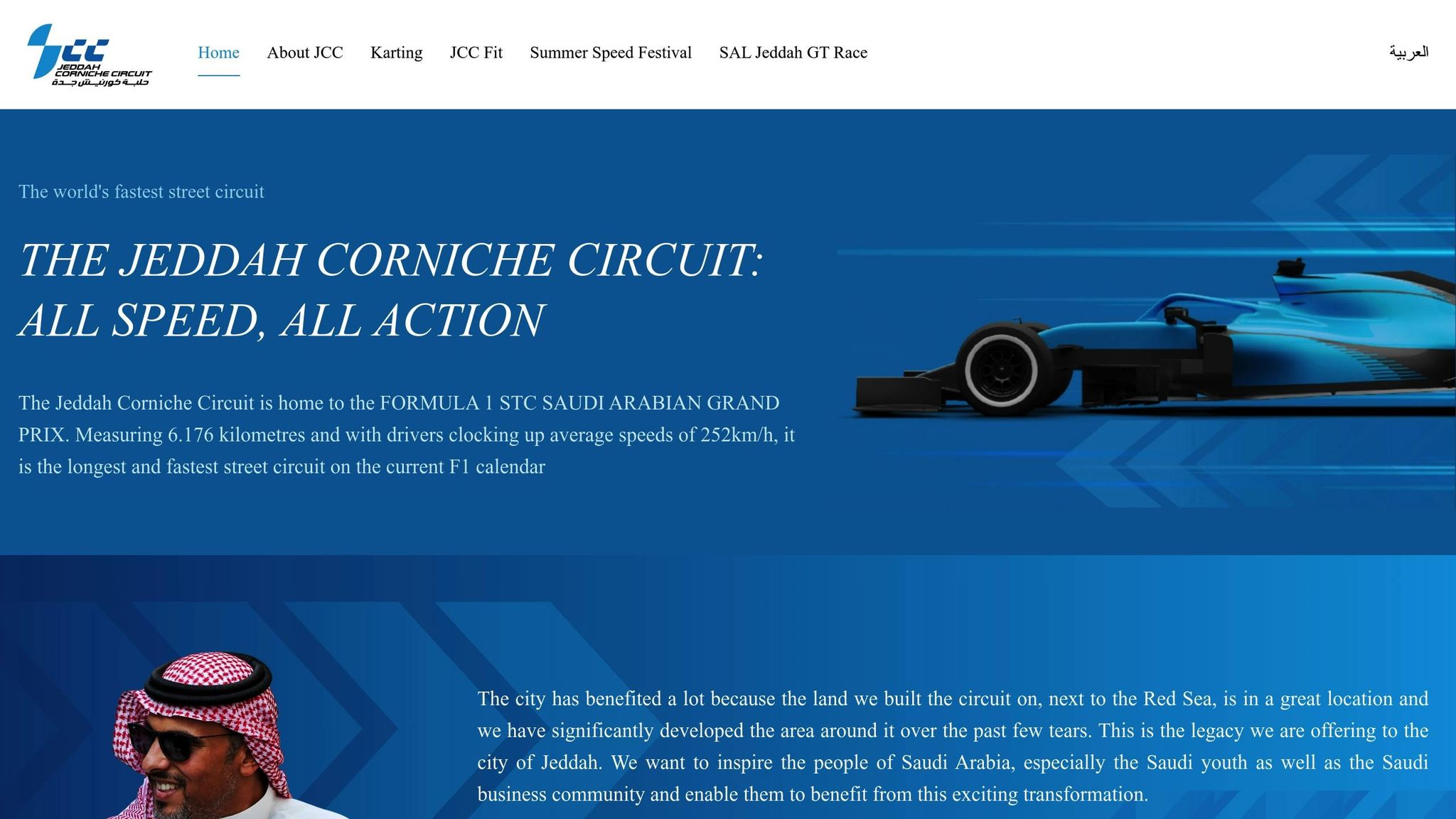
Track Layout and Key Features
Stretching 6.174 km along the Red Sea coastline, the Jeddah Corniche Circuit is a high-speed marvel crafted by Carsten Tilke. Its layout, while technically a street circuit, feels more like a permanent racing facility thanks to its flowing design.
The track boasts 27 corners that blend seamlessly into one another, demanding precision and focus from drivers. Ferrari has even described it as "a cross between Spa-Francorchamps and Monaco". Add in several long full-throttle sections, and teams are faced with the challenge of balancing low-drag setups for speed with enough downforce to maintain stability through the fast, winding curves.
The coastal location brings its own set of challenges. Sand from the Red Sea can sweep across the track, reducing grip - a phenomenon also observed at Abu Dhabi. On top of that, the circuit features three consecutive DRS zones, adding another layer of complexity to an already demanding layout.
"I have driven the lap many times on the simulator and with sections featuring walls close to the edge of the circuit, you really need to concentrate to avoid making a mistake. It will be very rewarding for those who can master all 27 corners."
– Carsten Tilke, F1 track designer
Unlike many urban circuits that focus on tight, technical turns, Jeddah prioritizes speed. Its sweeping curves and high-speed sections test driver precision and create a unique challenge that sets it apart from other street tracks.
Speed and Performance Data
When it comes to speed, Jeddah stands out as one of the fastest circuits in Formula One. With an average speed of 252.8 km/h (157.1 mph), it’s second only to Monza, which holds an average of 264.4 km/h. What’s more, drivers spend a staggering 79% of each lap at full throttle, underlining the track’s relentless pace.
| Speed Comparison | Average Speed | Full Throttle % |
|---|---|---|
| Jeddah Corniche | 252.8 km/h (157.1 mph) | 79% |
| Monza | 264.4 km/h (164.3 mph) | 75% |
Despite being the second-longest circuit on the calendar at 6.174 km - just behind Spa-Francorchamps - Jeddah delivers rapid lap times due to its high-speed nature. As noted, "with average speeds in excess of 250 km/h, the Jeddah Corniche Circuit is quite simply the fastest street circuit ever seen in the history of Formula 1."
These impressive stats directly shape the race strategies required to tackle this unique track.
How the Circuit Shapes Race Tactics
Jeddah’s high-speed layout doesn’t just test drivers - it also pushes teams to craft inventive strategies. The likelihood of a Safety Car is high, making the timing of pit stops a critical factor. With barriers so close, even minor mistakes can lead to significant incidents that disrupt the race.
Teams face a tricky balancing act when it comes to aerodynamics. Low-drag setups are essential for maximizing straight-line speed, but too little downforce can hurt performance in the demanding corners. This compromise often plays a decisive role in qualifying, where overtaking opportunities during the race are limited.
Tire management is another key consideration. The combination of sustained high speeds and energy-intensive corners puts significant thermal stress on the tires, forcing teams to carefully plan their strategies.
"We've seen in the past that sometimes the very soft tires are a little bit different the way that they feel in high-speed corners, and this weekend is definitely a high-speed track. So it will be interesting to know how we can get the C5s working this weekend."
– Alex Albon
Adding to the complexity, temperature shifts and changing wind conditions from practice to race day require ongoing adjustments to both tire performance and aerodynamic balance.
Night Racing: Challenges Under the Jeddah Floodlights
Temperature and Technical Factors
Racing at night under the Saudi Arabian sky presents unique challenges for Formula One teams. The Jeddah circuit is illuminated by the advanced Total Light Control – TLC for LED™ system, which uses over 2,200 fixtures to replicate daylight and meet international safety requirements.
Even with this state-of-the-art lighting, visibility remains a major concern. The circuit's fast, flowing layout and high-speed corners, bordered by walls, make spotting slower cars around certain turns tricky for drivers. This issue becomes even more critical when cars are flying down the track at average speeds of 155 mph (250 km/h). On top of that, the combination of artificial lighting and nighttime conditions subtly impacts track temperatures, influencing tire behavior and driver perception as they navigate the circuit's 27 corners.
"These tweaks are directly related to a drivers' sightline from the cockpit. It's minimal work, but it will help improve forward visibility in a couple of corners." – Martin Whitaker, Saudi Motorsport Company Chief Executive
These conditions demand quick thinking and razor-sharp decision-making, especially during pivotal moments of the race.
Key Moments: Starts, DRS Zones, and Pit Stops
Adding to these technical challenges, the dash to Turn 1 under intense artificial lighting requires drivers to make split-second decisions. The three DRS zones on the Jeddah circuit are critical overtaking opportunities, pushing drivers to weigh aggressive moves against the ever-present risk of narrow barriers. With roughly 80% of the lap spent at full throttle, combined with strategic DRS usage, the race often feels like a high-speed chess match.
"It looks like a really fast circuit, so I am excited to get out there and see how it feels in the car for real. I don't think I've ever driven on such a fast circuit before with so many high-speed corners, so I think it will be quite a challenge. Everyone is in the same position and hasn't had the opportunity to race there yet so practice sessions will prove to be very important to get our eye in." – Sergio Perez
Safety cars are a near certainty in Jeddah, with a 100% historical likelihood of intervention. These moments demand drivers to quickly adjust from high-speed racing to managing slower, tightly packed traffic. Teams also face the added pressure of adapting strategies on the fly, especially with a 19.2-second pit stop penalty hanging over every decision.
The combination of sustained high speeds and the visual demands of night racing takes a toll on drivers, testing their physical and mental endurance over the course of the race.
"We are confident these changes will lead to even faster, more exciting and – crucially – safe racing and we can't wait to see the world's greatest drivers battle it out here under the lights again in 2023." – Martin Whitaker, Chief Executive of the Saudi Motorsport Company
Team Tactics and Technical Changes for Jeddah in 2025
Aerodynamic and Mechanical Setups
Jeddah's fast and intricate layout in 2025 posed a unique challenge for teams, demanding a careful balance between aerodynamic efficiency and mechanical grip. The goal? Achieving straight-line speed without sacrificing cornering stability.
Aerodynamics took center stage, as engineers sought to maximize downforce while minimizing drag. This dual focus was crucial for navigating the circuit's mix of long straights and tight, high-speed turns. Teams leaned on lower-drag setups that still provided enough downforce to handle the demanding corners.
Suspension adjustments played a key role, with stiffer front settings enhancing responsiveness and softer rear setups aiding acceleration. Lower ride heights were also favored to improve aerodynamic performance, though careful calibration was needed to avoid contact with the curbs.
Differential settings were fine-tuned to improve corner entry rotation, enhance traction on exits, and reduce wheelspin. Hybrid power management became another critical factor, particularly on Jeddah's long straights with multiple DRS zones. Teams worked to optimize hybrid deployment for both attacking and defending positions during the race.
Once aerodynamic and mechanical setups were dialed in, teams shifted focus to tire strategies, ensuring they could fully exploit these technical improvements.
Tire Choices and Race Tactics
Pirelli's decision to introduce a softer tire range for Jeddah in 2025 reshaped race strategies. The C3, C4, and C5 compounds replaced the previous year's harder options, offering teams new opportunities to experiment.
"This is in line with the aim, shared with the FIA, F1 and the teams, to create more strategy choices for the race and therefore more exciting and unpredictable racing", Pirelli noted in their weekend preview.
The one-stop strategy remained a popular choice, as seen in 2024 when Max Verstappen effectively used it, starting on mediums and switching to hards during a safety car period on lap 7. This strategy was mirrored by most of the field, with 14 of the 18 finishers adopting a similar approach.
However, the softer compounds in 2025 encouraged alternative tactics. Some drivers opted to start on soft tires for an early pace advantage, relying on their ability to manage wear during the opening stint. Cooler night temperatures at Jeddah further influenced tire degradation, allowing drivers to push harder for longer compared to daytime races. Additionally, teams strategically saved hard tire sets during practice and qualifying, anticipating the high likelihood of safety car interruptions, a hallmark of racing at Jeddah.
Safety Car and Pit Stop Tactics
Given Jeddah's tight layout and high speeds, safety car interventions were almost guaranteed, with teams building their strategies around these interruptions. The ability to time pit stops perfectly and adapt quickly to changing race conditions became a defining factor in 2025.
"It's interesting that teams decided to keep both sets of hard... they shouldn't be used in a normal situation but we know Safety Car probability here is quite high, and if you have to move from one stop to two stops, the hard is the best tire", explained Mario Isola, Pirelli's Director of Motorsport.
Jeddah's short pit lane, with an approximate 15-second time loss, encouraged teams to take bold risks during safety car periods. This reduced time penalty made aggressive pit strategies more viable, especially when the field was bunched under caution.
Historical data supported this approach. Between 2021 and 2024, the first four races at Jeddah saw only 64 pit stops in total, averaging less than one stop per driver per race. This low average highlighted the effectiveness of one-stop strategies and the importance of timing pit stops during safety car periods.
To further mitigate risks, teams often employed split strategies between their drivers, preparing for different safety car scenarios. As Oracle Red Bull Racing noted:
"The trick is to be prepared and not get caught out," a sentiment that emphasized the importance of quick decision-making. With five full safety car periods and two red flags across the first four races, teams that excelled in analyzing tire wear, fuel levels, and track position - while maintaining clear communication - gained a decisive edge over their competitors.
Driver Performances and Key Moments of the 2025 Race
Top Performers: Piastri's Victory and the Podium Battle
Oscar Piastri delivered an impressive performance at Jeddah, claiming his third win of the 2025 season and climbing to the top of the Drivers' Championship standings. This milestone made him the first Australian driver in 15 years to lead the championship. The race began with drama as Verstappen picked up a five-second penalty for going off-track on the opening lap. This early setback opened the door for Piastri, who executed a precise overtake on Hamilton at Turn 22, navigating the tight space by the concrete barriers. From there, he built a strong lead, ultimately crossing the finish line 2.8 seconds ahead, ending Red Bull's four-year reign at the top.
Piastri reflected on his victory, saying:
"It was a pretty tough race. Very happy to have obviously won, made the difference at the start. [I] made my case into Turn 1 and that was enough. It was really tricky to follow out there, I couldn't really stay with Max at the end of the first stint, just chewed up my tyres and then the clean air was nice after the pit stops",.
He added:
"Great race, we did the parts we needed to right. Still need a bit more I think, Max was a little bit too close for our liking but a great race and a great weekend",.
These defining moments highlighted the intensity of the on-track battles and the relentless focus required to succeed in such a high-stakes environment.
Overtakes and Incidents
The race was shaped by more than just strategy - it was the drivers’ split-second decisions and daring maneuvers that truly stood out. Jeddah’s 27-turn layout, notorious for its unforgiving corners, demanded aggressive moves, where even the smallest misstep could have severe consequences.
Driver Challenges: Narrow Walls and High-Speed Demands
Jeddah’s circuit pushed drivers to their absolute limits, blending technical challenges with physical and mental strain. Known as the fastest street circuit in the world, it required flawless precision. The concrete walls, combined with the high speeds and nighttime conditions, left no room for error. Reflecting on the unique challenges, Zhou Guanyu noted:
"Especially in Q1 and also the last one in Q2. Especially here with the high-speed, with the wind, it could be a bit tricky."
Isack Hadjar emphasized the unforgiving nature of the track:
"You can't really make mistakes here, it's concrete walls, not barriers or tyres."
For younger drivers, Jeddah presented an even steeper learning curve. Kimi Antonelli shared his perspective:
"This track is such a big test as you need lots of confidence and to get really close to the walls through the high-speed corners. Step-by-step, and the more experience I'm getting, I feel like I'm starting to put it all together with more consistency."
Beyond navigating the circuit itself, drivers had to adjust to the stark contrast between low-fuel qualifying laps and high-fuel race conditions. Tire management became a crucial factor, especially as the race unfolded under variable conditions. Liam Lawson summed up the dual nature of racing at Jeddah:
"It's exciting to drive, it raises the heart rate, but obviously it bites hard as well which we've seen today."
From the razor-thin margins of overtaking to the relentless concentration demanded by the high-speed layout, Jeddah proved to be a true test of skill, confidence, and resilience for Formula One’s finest.
Everything we learned from F1's 2025 Saudi Arabian GP
Jeddah's Place as Formula One's Fastest Street Race
The 2025 Saudi Arabian Grand Prix solidified Jeddah's reputation as the fastest street circuit in Formula One, a track where speed meets precision like nowhere else. While Monza still holds the crown as the fastest overall circuit with qualifying speeds hitting an average of 161.4 mph, Jeddah isn’t far behind with a blistering qualifying average of 158.2 mph - making it the quickest among urban tracks.
Stretching 3.836 miles (6.174 km) and featuring 27 corners, the Jeddah Corniche Circuit demands unwavering focus and split-second decision-making from drivers. Its unique combination of length and complexity directly impacts both car setups and race strategies, pushing teams to find the perfect balance.
But Jeddah isn’t just about speed - it’s also a test of technical finesse. In the 2025 race, teams like McLaren, Ferrari, and Red Bull introduced cutting-edge aerodynamic designs to reduce drag while maintaining the downforce necessary for navigating the circuit's high-speed corners. As Tim Wright, Aston Martin’s deputy performance engineer, put it:
"Jeddah is a straightforward circuit as it demands high efficiency - a car without too much drag... It's got amazing high-speed corners, but you can't just put a big rear wing on the car because there's so much drag sensitivity."
Since its debut in 2021, the track has seen safety updates to enhance driver protection without compromising its high-speed thrills.
Jeddah’s challenges extend beyond the physical track. Night racing conditions, careful tire management with Pirelli's softer compounds, and the looming threat of safety car interruptions add layers of complexity to the race. Success here requires more than just raw speed - it demands tactical brilliance. This makes Jeddah the ultimate stage where drivers and teams demonstrate their ability to combine speed, strategy, and precision under intense pressure.
FAQs
Why is the Jeddah Corniche Circuit considered the fastest street track in Formula One?
Jeddah Corniche Circuit: The Fastest Street Track in Formula One
The Jeddah Corniche Circuit stands out as the fastest street track in Formula One, thanks to its distinctive design. Featuring high-speed sweeping corners and extended straights, this track pushes F1 cars to their absolute limits. Its smooth, low-abrasion surface not only enhances grip but also minimizes tire wear, allowing drivers to sustain incredible speeds throughout the race.
What makes this circuit even more challenging is its layout, which forces teams to fine-tune car setups for a perfect balance of speed and precision. On top of that, drivers must navigate the added complexity of a night race, where sharp reflexes and heightened focus are essential due to limited visibility. All these factors come together to deliver an electrifying experience that sets this track apart from every other street circuit on the F1 calendar.
How does racing at night in Jeddah influence drivers and team strategies?
Racing under the lights in Jeddah brings a whole new set of challenges and opportunities for both drivers and teams. The cooler track temperatures at night enhance tire grip and improve car handling, but as the race progresses and temperatures drop further, the track conditions can become unpredictable.
Teams have to think on their feet, carefully planning tire strategies and pit stops to keep up with the ever-changing surface. Meanwhile, drivers face the dual challenge of adapting to these shifting conditions and dealing with limited visibility. This combination often sparks bold moves and inventive tactics, making the Jeddah night race an electrifying highlight in the Formula 1 calendar.
What were the main factors behind Oscar Piastri's win at the 2025 Saudi Arabian Grand Prix?
Oscar Piastri's Triumph at the 2025 Saudi Arabian Grand Prix
Oscar Piastri clinched victory at the 2025 Saudi Arabian Grand Prix thanks to a combination of skill, strategy, and timing. His ability to sustain an impressive race pace while managing tire wear with precision gave him a crucial edge on Jeddah's demanding high-speed street circuit.
One of the defining moments of the race came when a safety car was deployed after an incident involving Max Verstappen. Piastri and his McLaren team seized this opportunity with impeccable timing, making strategic decisions that positioned him for success.
Beyond this, Piastri's composure under the challenging night conditions and McLaren's flawless execution of their race plan played a significant role in his achievement. Together, these factors culminated in a standout performance and a victory that showcased both his talent and teamwork.
Related posts
- Track by Track: The Complete Story of the 2025 Formula 1 Calendar
- Monaco Grand Prix Circuit Guide: The Prestige, Precision, and Pressure of F1’s Crown Jewel
- Jeddah Corniche Circuit: The High-Speed Street Track Redefining Night Racing in Saudi Arabia
- Lusail International Circuit: Qatar’s Ascent in Formula 1 and Its Technical Demands

